现代词汇学重点
- 格式:doc
- 大小:25.50 KB
- 文档页数:4
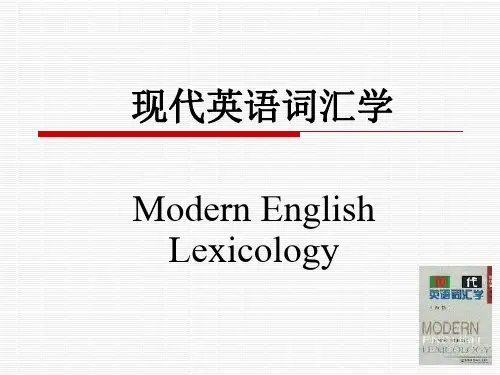
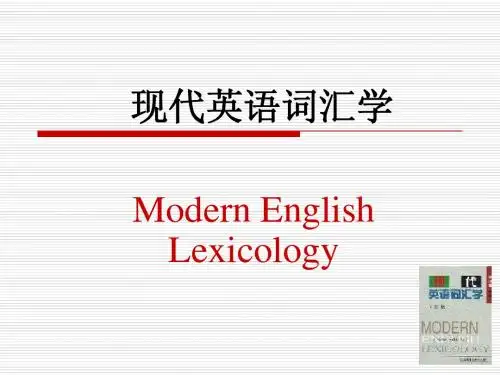
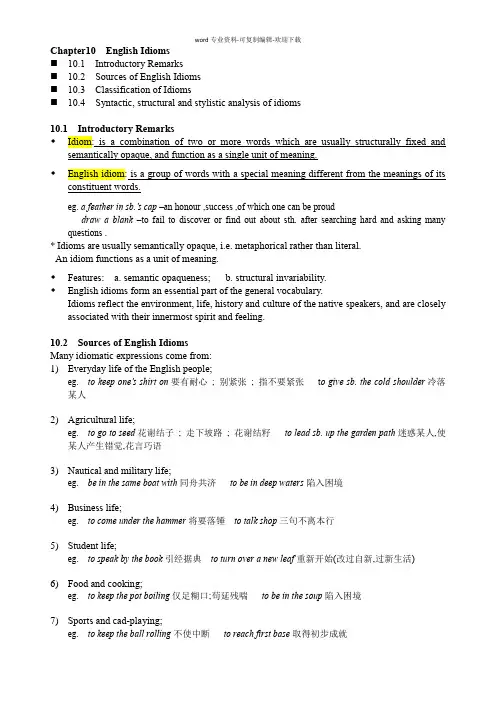
Chapter10 English Idioms⏹10.1 Introductory Remarks⏹10.2 Sources of English Idioms⏹10.3 Classification of Idioms⏹10.4 Syntactic, structural and stylistic analysis of idioms10.1 Introductory Remarks♦Idiom: is a combination of two or more words which are usually structurally fixed and semantically opaque, and function as a single unit of meaning.♦English idiom: is a group of words with a special meaning different from the meanings of its constituent words.eg. a feather in sb.’s cap –an honour ,success ,of which one can be prouddraw a blank–to fail to discover or find out about sth. after searching hard and asking many questions .*Idioms are usually semantically opaque, i.e. metaphorical rather than literal.An idiom functions as a unit of meaning.♦Features: a. semantic opaqueness; b. structural invariability.♦English idioms form an essential part of the general vocabulary.Idioms reflect the environment, life, history and culture of the native speakers, and are closely associated with their innermost spirit and feeling.10.2 Sources of English IdiomsMany idiomatic expressions come from:1)Everyday life of the English people;eg. to keep one’s shirt on要有耐心; 别紧张; 指不要紧张t o give sb. the cold shoulder冷落某人2)Agricultural life;eg. to go to seed花谢结子; 走下坡路; 花谢结籽to lead sb. up the garden path迷惑某人,使某人产生错觉,花言巧语3)Nautical and military life;eg. be in the same boat with同舟共济to be in deep waters陷入困境4)Business life;eg. to come under the hammer将要落锤to talk shop三句不离本行5)Student life;eg. to speak by the book引经据典to turn over a new leaf重新开始(改过自新,过新生活)6)Food and cooking;eg. to keep the pot boiling仅足糊口;苟延残喘to be in the soup陷入困境7)Sports and cad-playing;eg. to keep the ball rolling不使中断to reach first base取得初步成就8)The Bible;eg. a thorn in the flesh肉中刺,眼中钉,烦恼的根源to turn the other cheek忍气吞声t he apple of one’s eyes掌上明珠9)Shakespeare’s plays;eg. to flutter the dovecotes扰乱鸽棚to give the Devil his due勿掩恶人善,平心而论10)fables, myths or legends.eg. sour grapes(指某人因得不到某物而称该事物不好)酸葡萄the lion’s share(最大份额或最大的一份)狮子的份额10.3 Classification of IdiomsThere are several criteria of classification of idioms. We classify them by structural criterion.A.Phrase idioms 短语成语According to the central word , they may subdivided into:1.Verb phrase idiom*a)All common English verbs, most of which are of native Anglo-Saxon origin, can combine with adverbs and prepositions to form phrasal verbs.b)Most of the verb phrase idioms are often nearly synonymous with loan words of Roman origin.c)Verb phrase idioms can form noun compounds.d)Phrasal verbs usually more lively and expressive than single verbs.eg. fall flat大失所望; 残败bite the hand that feeds one以怨报德2. Noun phrase idiomThe commonest functions of noun phrase idioms:a)As the direct object of a clause;b)As the complement of a clause;c)As the object of a preposition.eg. a baker’s dozen 十三个Jack of all trades 万事通; 万金油3. Adjective phrase idiomThe commonest function of adjective phrase idioms is as complement of a clause.eg. high and mighty盛气凌人;趾高气扬wide of the mark毫不沾边4. Prepositional phrase idiomFunctions of prepositional phrase idioms are:a)As an adjunct modifying a verb; 附属修饰语b)As a complement;补语c)As a complement or adjunct;d)As a disjunct; 分离判断语,附加语e)As a connecting phrase.B.Clause idioms 无主语从句成语Most of these idioms are terse, colloquial, vivid and changed with life.1.Verb + complement pattern2.Verb + direct object pattern3.Verb + direct object + complement pattern4.Verb + indirect object + direct object pattern5.Verb + direct object + adjunct patternC.Sentence idioms句子成语1.Proverbs;2.Typical conversational expressionseg. Upon my word! 我敢担保!Well begun is half done.半途而废Kill the goose that laid the golden egg. 毁掉财路; 杀鸡取卵10.4 Syntactic, structural and stylistic analysis of idiomsA. syntactic function 句法的功能1.The syntactic function of most phrase idioms usually corresponds with the central word or components.2.The syntactic function of some phrase idioms can vary.3.Prepositional phrase idioms have very diverse functions.4.noun + noun phrases have diverse functions.eg. He has a gift of the gab.(the ability to talk readily and easily )B. transformational restrictions 结构转换的限制性Transformation is a matter of structural change, and the change may be of various kinds.1.Some verb phrases may change word order.2.Some cannot change their word order.3.Some verb phrases may be passivized, but some can not.4.Most of the clause idioms cannot be put into the passive voice, while some of them can be used either way.5.The direct object usually does not undergo passive transformation; only the indirect object can be passivized.6.Some clause idioms may be made passive with a meaning quite different from what it had in the active form.C. Collocative restrictions 搭配限制1. Words collocate with idioms as the subjects, objects, predicates etc. of different types of phrase and clause idioms.2. Some idioms have a wide range of collocates while some have a limited choice.3. For some idioms, one has to consider which collocates will serve as adjuncts.D. Structural variability结构变化Idioms are structurally fixed, and as a rule one are not supposed to change any element in an idiomatic expression. But it is not unusual for writers to give a new twist to an old saying by making slight changes for rhetorical effect.Some ways of alteration in idioms:1. The replacement of one element by another without affecting the meaning of the whole.2. Insertion of one or more words into an idiomatic expression without changing its basic meaning.3. Deletion of one or more words, especially articles.E. Stylistic features文体特征1. Most idioms are stylistically neutral;2. But some of them belong to informal spoken English;3. Some idiom phrases are slangy.。
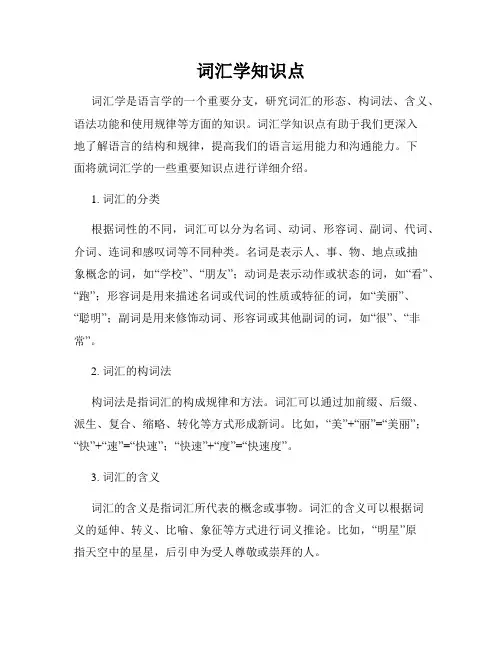
词汇学知识点词汇学是语言学的一个重要分支,研究词汇的形态、构词法、含义、语法功能和使用规律等方面的知识。
词汇学知识点有助于我们更深入地了解语言的结构和规律,提高我们的语言运用能力和沟通能力。
下面将就词汇学的一些重要知识点进行详细介绍。
1. 词汇的分类根据词性的不同,词汇可以分为名词、动词、形容词、副词、代词、介词、连词和感叹词等不同种类。
名词是表示人、事、物、地点或抽象概念的词,如“学校”、“朋友”;动词是表示动作或状态的词,如“看”、“跑”;形容词是用来描述名词或代词的性质或特征的词,如“美丽”、“聪明”;副词是用来修饰动词、形容词或其他副词的词,如“很”、“非常”。
2. 词汇的构词法构词法是指词汇的构成规律和方法。
词汇可以通过加前缀、后缀、派生、复合、缩略、转化等方式形成新词。
比如,“美”+“丽”=“美丽”;“快”+“速”=“快速”;“快速”+“度”=“快速度”。
3. 词汇的含义词汇的含义是指词汇所代表的概念或事物。
词汇的含义可以根据词义的延伸、转义、比喻、象征等方式进行词义推论。
比如,“明星”原指天空中的星星,后引申为受人尊敬或崇拜的人。
4. 词汇的语法功能词汇在句子中具有不同的语法功能,如名词可以作主语、宾语、定语、表语等;动词可以表示主谓关系、宾语关系、状语关系等;形容词和副词可以修饰名词或代词等。
5. 词汇的使用规律词汇在语言运用中有一定的使用规律,比如词的搭配、语法环境、语言风格等。
正确地运用词汇有助于提高语言表达的准确性和丰富性。
通过以上对词汇学知识点的介绍,我们可以更系统地了解词汇在语言中的作用和重要性,进一步提高我们的语言水平和表达能力。
希望大家都能在学习词汇学知识点的过程中取得更好的成绩,展现自己在语言运用方面的能力。
【正文结束】。
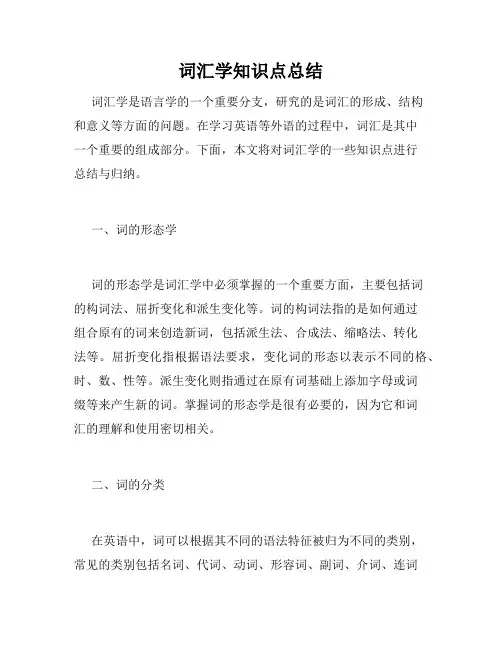
词汇学知识点总结词汇学是语言学的一个重要分支,研究的是词汇的形成、结构和意义等方面的问题。
在学习英语等外语的过程中,词汇是其中一个重要的组成部分。
下面,本文将对词汇学的一些知识点进行总结与归纳。
一、词的形态学词的形态学是词汇学中必须掌握的一个重要方面,主要包括词的构词法、屈折变化和派生变化等。
词的构词法指的是如何通过组合原有的词来创造新词,包括派生法、合成法、缩略法、转化法等。
屈折变化指根据语法要求,变化词的形态以表示不同的格、时、数、性等。
派生变化则指通过在原有词基础上添加字母或词缀等来产生新的词。
掌握词的形态学是很有必要的,因为它和词汇的理解和使用密切相关。
二、词的分类在英语中,词可以根据其不同的语法特征被归为不同的类别,常见的类别包括名词、代词、动词、形容词、副词、介词、连词和感叹词等。
不同的词在句子中扮演着不同的角色,掌握各类别之间的区别以及它们在句子中的作用,可以帮助我们更好地理解和表达语言。
三、词义词义是从语言学的角度定义词的意义,包括原义和引申义。
原义指的是一个词最基本的意思,而引申义则是在原义基础上经过延伸、扩展而得到的新意义。
同一个词的不同意义和语言环境等也会导致其含义的变化,例如“bank”既可以表示银行,也可以表示河岸等。
在学习外语的过程中,掌握词义是十分重要的。
四、词汇的学习方法词汇的学习是英语学习中最基础也最重要的部分之一,因此选择适合自己的学习方法对于提高词汇量、扩大词汇面积至关重要。
常用的学习方法包括反复背诵、积累单词簿、整理词根词缀、阅读和听力等。
在学习方法上,以选择适合自己和有用的方法为主,同时注意与语言运用的联系,不断地推广和实践。
五、词汇的应用掌握了词汇学的知识和学习方法后,其实就迈出了学习英语的第一步。
在实际运用中,如何运用得当也是至关重要的环节。
为了提高语言的流利度,需要在口语和书面语两个方面加强实践,增强实际运用能力。
另外,可以较晚多在社交网络等平台上与外国人联系,使用所学的词汇,将知识应用到实际交流之中,效果更佳。

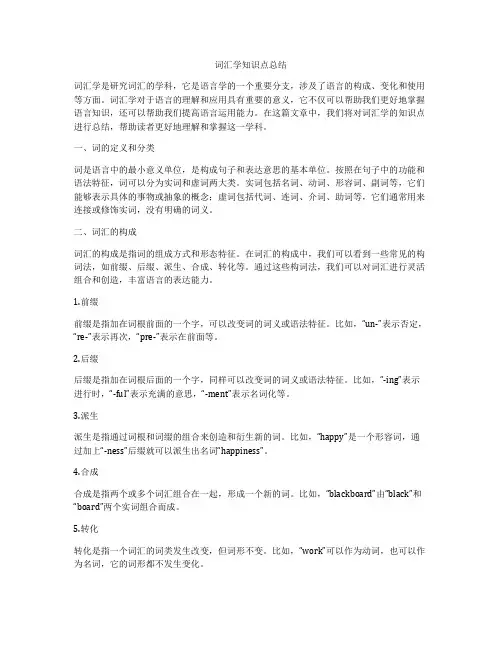
词汇学知识点总结词汇学是研究词汇的学科,它是语言学的一个重要分支,涉及了语言的构成、变化和使用等方面。
词汇学对于语言的理解和应用具有重要的意义,它不仅可以帮助我们更好地掌握语言知识,还可以帮助我们提高语言运用能力。
在这篇文章中,我们将对词汇学的知识点进行总结,帮助读者更好地理解和掌握这一学科。
一、词的定义和分类词是语言中的最小意义单位,是构成句子和表达意思的基本单位。
按照在句子中的功能和语法特征,词可以分为实词和虚词两大类。
实词包括名词、动词、形容词、副词等,它们能够表示具体的事物或抽象的概念;虚词包括代词、连词、介词、助词等,它们通常用来连接或修饰实词,没有明确的词义。
二、词汇的构成词汇的构成是指词的组成方式和形态特征。
在词汇的构成中,我们可以看到一些常见的构词法,如前缀、后缀、派生、合成、转化等。
通过这些构词法,我们可以对词汇进行灵活组合和创造,丰富语言的表达能力。
1.前缀前缀是指加在词根前面的一个字,可以改变词的词义或语法特征。
比如,“un-”表示否定,“re-”表示再次,“pre-”表示在前面等。
2.后缀后缀是指加在词根后面的一个字,同样可以改变词的词义或语法特征。
比如,“-ing”表示进行时,“-ful”表示充满的意思,“-ment”表示名词化等。
3.派生派生是指通过词根和词缀的组合来创造和衍生新的词。
比如,“happy”是一个形容词,通过加上“-ness”后缀就可以派生出名词“happiness”。
4.合成合成是指两个或多个词汇组合在一起,形成一个新的词。
比如,“blackboard”由“black”和“board”两个实词组合而成。
5.转化转化是指一个词汇的词类发生改变,但词形不变。
比如,“work”可以作为动词,也可以作为名词,它的词形都不发生变化。
词汇的构成方式是多种多样的,通过学习这些构词法,我们可以更好地理解和掌握词汇的形态特征,有助于提高我们的语言表达能力。
三、词汇的语义特征语义是指词汇所携带的意义,它是语言交流和理解的基础。
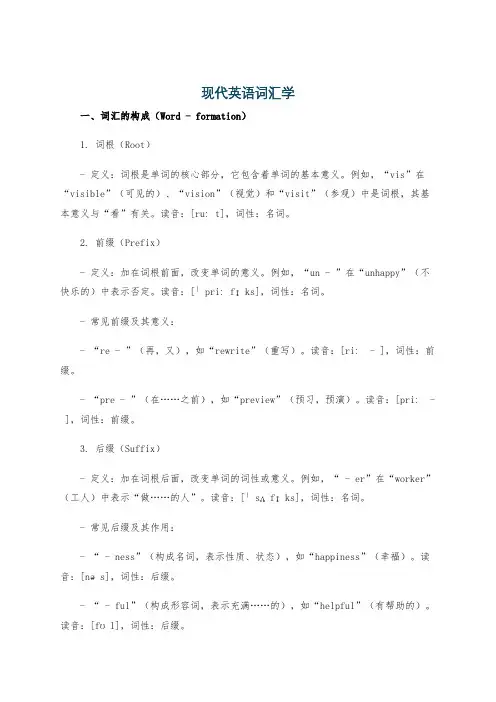
现代英语词汇学一、词汇的构成(Word - formation)1. 词根(Root)- 定义:词根是单词的核心部分,它包含着单词的基本意义。
例如,“vis”在“visible”(可见的)、“vision”(视觉)和“visit”(参观)中是词根,其基本意义与“看”有关。
读音:[ruːt],词性:名词。
2. 前缀(Prefix)- 定义:加在词根前面,改变单词的意义。
例如,“un - ”在“unhappy”(不快乐的)中表示否定。
读音:[ˈpriːfɪks],词性:名词。
- 常见前缀及其意义:- “re - ”(再,又),如“rewrite”(重写)。
读音:[riː - ],词性:前缀。
- “pre - ”(在……之前),如“preview”(预习,预演)。
读音:[priː - ],词性:前缀。
3. 后缀(Suffix)- 定义:加在词根后面,改变单词的词性或意义。
例如,“ - er”在“worker”(工人)中表示“做……的人”。
读音:[ˈsʌfɪks],词性:名词。
- 常见后缀及其作用:- “ - ness”(构成名词,表示性质、状态),如“happiness”(幸福)。
读音:[nəs],词性:后缀。
- “ - ful”(构成形容词,表示充满……的),如“helpful”(有帮助的)。
读音:[fʊl],词性:后缀。
二、词性(Parts of Speech)1. 名词(Noun)- 定义:表示人、事物、地点、抽象概念等。
例如,“book”(书)、“city”(城市)、“love”(爱)。
读音:[naʊn],词性:名词。
- 名词的分类:- 可数名词(Countable Noun),如“apple”(苹果),有单复数形式。
- 不可数名词(Uncountable Noun),如“water”(水),一般没有复数形式。
2. 动词(Verb)- 定义:表示动作或状态。
例如,“run”(跑)、“be”(是)。
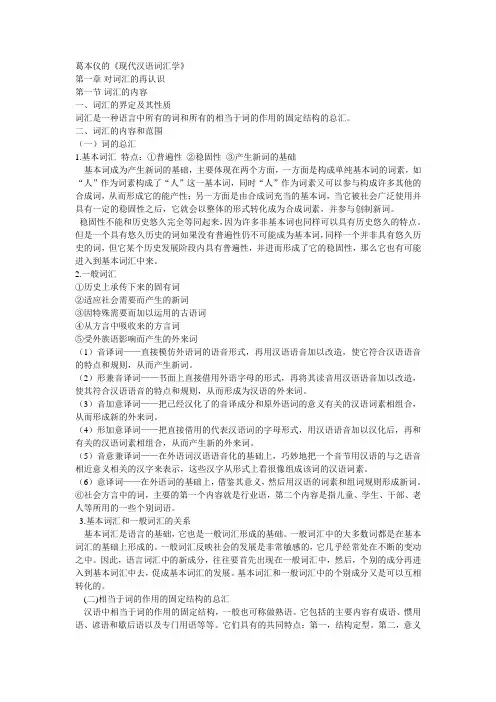
葛本仪的《现代汉语词汇学》第一章对词汇的再认识第一节词汇的内容一、词汇的界定及其性质词汇是一种语言中所有的词和所有的相当于词的作用的固定结构的总汇。
二、词汇的内容和范围(一)词的总汇1.基本词汇特点:①普遍性②稳固性③产生新词的基础基本词成为产生新词的基础,主要体现在两个方面,一方面是构成单纯基本词的词素,如“人”作为词素构成了“人”这一基本词,同时“人”作为词素又可以参与构成许多其他的合成词,从而形成它的能产性;另一方面是由合成词充当的基本词,当它被社会广泛使用并具有一定的稳固性之后,它就会以整体的形式转化成为合成词素,并参与创制新词。
稳固性不能和历史悠久完全等同起来,因为许多非基本词也同样可以具有历史悠久的特点。
但是一个具有悠久历史的词如果没有普遍性仍不可能成为基本词,同样一个并非具有悠久历史的词,但它某个历史发展阶段内具有普遍性,并进而形成了它的稳固性,那么它也有可能进入到基本词汇中来。
2.一般词汇①历史上承传下来的固有词②适应社会需要而产生的新词③因特殊需要而加以运用的古语词④从方言中吸收来的方言词⑤受外族语影响而产生的外来词(1)音译词——直接模仿外语词的语音形式,再用汉语语音加以改造,使它符合汉语语音的特点和规则,从而产生新词。
(2)形兼音译词——书面上直接借用外语字母的形式,再将其读音用汉语语音加以改造,使其符合汉语语音的特点和规则,从而形成为汉语的外来词。
(3)音加意译词——把已经汉化了的音译成分和原外语词的意义有关的汉语词素相组合,从而形成新的外来词。
(4)形加意译词——把直接借用的代表汉语词的字母形式,用汉语语音加以汉化后,再和有关的汉语词素相组合,从而产生新的外来词。
(5)音意兼译词——在外语词汉语语音化的基础上,巧妙地把一个音节用汉语的与之语音相近意义相关的汉字来表示,这些汉字从形式上看很像组成该词的汉语词素。
(6)意译词——在外语词的基础上,借鉴其意义,然后用汉语的词素和组词规则形成新词。
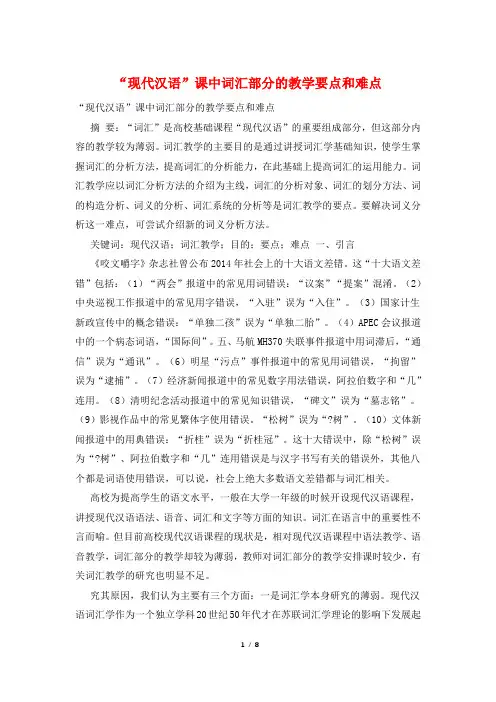
“现代汉语”课中词汇部分的教学要点和难点“现代汉语”课中词汇部分的教学要点和难点摘要:“词汇”是高校基础课程“现代汉语”的重要组成部分,但这部分内容的教学较为薄弱。
词汇教学的主要目的是通过讲授词汇学基础知识,使学生掌握词汇的分析方法,提高词汇的分析能力,在此基础上提高词汇的运用能力。
词汇教学应以词汇分析方法的介绍为主线,词汇的分析对象、词汇的划分方法、词的构造分析、词义的分析、词汇系统的分析等是词汇教学的要点。
要解决词义分析这一难点,可尝试介绍新的词义分析方法。
关键词:现代汉语;词汇教学;目的;要点;难点一、引言《咬文嚼字》杂志社曾公布2014年社会上的十大语文差错。
这“十大语文差错”包括:(1)“两会”报道中的常见用词错误:“议案”“提案”混淆。
(2)中央巡视工作报道中的常见用字错误,“入驻”误为“入住”。
(3)国家计生新政宣传中的概念错误:“单独二孩”误为“单独二胎”。
(4)APEC会议报道中的一个病态词语,“国际间”。
五、马航MH370失联事件报道中用词滞后,“通信”误为“通讯”。
(6)明星“污点”事件报道中的常见用词错误,“拘留”误为“逮捕”。
(7)经济新闻报道中的常见数字用法错误,阿拉伯数字和“几”连用。
(8)清明纪念活动报道中的常见知识错误,“碑文”误为“墓志铭”。
(9)影视作品中的常见繁体字使用错误。
“松树”误为“?树”。
(10)文体新闻报道中的用典错误:“折桂”误为“折桂冠”。
这十大错误中,除“松树”误为“?树”、阿拉伯数字和“几”连用错误是与汉字书写有关的错误外,其他八个都是词语使用错误,可以说,社会上绝大多数语文差错都与词汇相关。
高校为提高学生的语文水平,一般在大学一年级的时候开设现代汉语课程,讲授现代汉语语法、语音、词汇和文字等方面的知识。
词汇在语言中的重要性不言而喻。
但目前高校现代汉语课程的现状是,相对现代汉语课程中语法教学、语音教学,词汇部分的教学却较为薄弱,教师对词汇部分的教学安排课时较少,有关词汇教学的研究也明显不足。
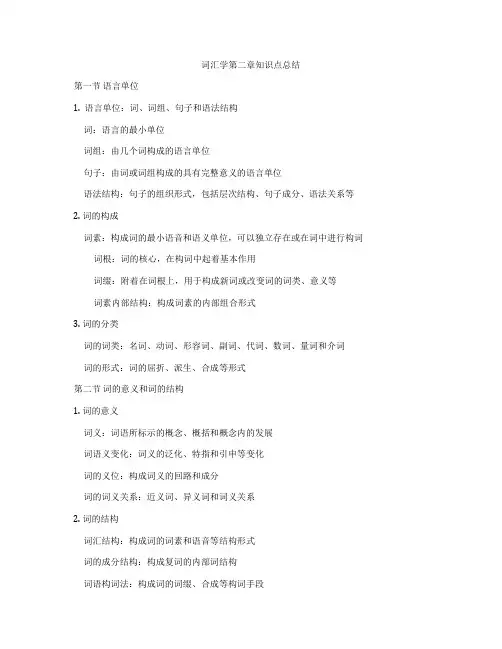
词汇学第二章知识点总结第一节语言单位1. 语言单位:词、词组、句子和语法结构词:语言的最小单位词组:由几个词构成的语言单位句子:由词或词组构成的具有完整意义的语言单位语法结构:句子的组织形式,包括层次结构、句子成分、语法关系等2. 词的构成词素:构成词的最小语音和语义单位,可以独立存在或在词中进行构词词根:词的核心,在构词中起着基本作用词缀:附着在词根上,用于构成新词或改变词的词类、意义等词素内部结构:构成词素的内部组合形式3. 词的分类词的词类:名词、动词、形容词、副词、代词、数词、量词和介词词的形式:词的屈折、派生、合成等形式第二节词的意义和词的结构1. 词的意义词义:词语所标示的概念、概括和概念内的发展词语义变化:词义的泛化、特指和引申等变化词的义位:构成词义的回路和成分词的词义关系:近义词、异义词和词义关系2. 词的结构词汇结构:构成词的词素和语音等结构形式词的成分结构:构成复词的内部词结构词语构词法:构成词的词缀、合成等构词手段第三节词义关系和词义演变1. 词义关系上下位关系:词义之间的概括和被概括关系同类词关系:在特定范畴或范围内词义之间的同类关系词语义联系:在使用中词义之间的联系和联系表达2. 词义演变词义的演变:在历史发展和使用中词义的变化和扩展词义变化类型:词义的泛化、转移、借代、内涵、外延等变化类型词义变化因素:历史、社会、文化、语言接触等诸多因素第四节词在句法中的功能和语意1. 词的句法功能词的句法功能:在句中词所承担的成分和功能句法结构:构成句子的各种句法成分的组织形式2. 词的语义特征词的语义特征:词的语义属性和特别意义词的意义转换:词义在句法中的隐喻、比喻、借代和辞让等转换方式词义在句法中的表现:词义在句中所呈现的语义特征和语义表达第五节词汇的心理基础1. 词汇的心理组织词的心理存储:词的存储方式和内部心理结构词汇记忆:词的认知和记忆方式及其规律词的心理连接:词之间在心理中的联结和联系2. 词汇的心理活动词的心理组织:词的认知、思维、理解、表达等心理活动词的心理过程:词的产生、使用、决策、回忆、判断等心理过程第六节词汇习得和使用1. 词汇的习得语言习得:语言学习者获取和掌握词汇的过程词汇习得理论:第一语言习得和第二语言习得的理论及其实践词汇习得策略:词汇习得过程中的学习策略和方法2. 词汇的使用词汇的应用范畴:词汇在语言和交际中的各种应用范畴和方式词汇的使用规律:词汇在使用中的频率、变化、地域差异等规律词汇的使用技巧:词汇使用中的技巧、技能、风格等第七节词汇学的理论和研究方法1. 词汇学的理论词汇研究理论:词汇研究的主流理论和方法词汇学派别:各种词汇学派别对词汇研究的探索和发展词汇发展趋势:未来词汇研究的方向、趋势、发展和应用2. 词汇学的研究方法词汇的研究方法:词汇的描述、分析、解释的研究方法和手段词汇的实证研究:词汇在使用中的实证研究方法和技术词汇的应用研究:词汇在语言学、教育学、心理学等领域的应用研究以上是词汇学第二章的知识点总结。
张韵斐著《现代英语词汇学概论》——解析第一部分Chapter Ⅰ英语词汇得概论(Ageneralsurvey ofEnglish vocabu lary)Bloomfield1933中对词得定义就是,每个单词都就是最小得自由词.然而这个定义不够全面,存在着缺陷。
首先,不就是所有得单词都可以独立出现,如the ,a ,my 这些单词单独出现则没有具体意义.另外,Bloomfield得定义侧重在于语法(syntax)却没有涉及到词得意义。
随着词汇学得发展跟完善,人们给词下了较为完整得定义.“词,今指语言组织中得基础单位,能独立运用,具有声音、意义与语法功能。
”(《辞海》1984(上)375页,上海辞书出版社)一种语言中所有得单词汇集起来便构成了该语言得词库。
纵观英语得发展历史,我们可以知道,大多数得英语词汇都就是外来词,它从拉丁语,法语与希腊语等语言中汲取词汇,不断得扩充自己,为己所用.特别就是第二次世界大战之后,英语词汇得到了空前得发展。
现代英语词汇快速发展得原因主要有四方面。
一就是科学技术得快速发展,二就是社会经济得全球化,三就是英语国家得政治与文化变化,最后就是其她文化与语言对英语得强烈影响。
英语词汇就是由各种不同类型得单词组成,而这些单词有着不同得分类标准。
根据词得起源可以分为本族语与外来语;根据使用水平可以分为普通词汇,文学词汇。
口头词汇,俚语以及科学术语.基础语库得基本特征就是具有民族特征,稳定性,构词得能力与搭配能力。
第二部分Chapter Ⅱ到Chapter Ⅳ英语词汇得形态结构与词得构词(Morphologicalstructure of Engli shwords and word—formation)(一)词素(Morphemes)单词就是有词素(morphemes)构成得。
词素即英语语言中有意义得最小单位,同时具有声音与意义.单词可以有一个或一个以上得词素组成。
如:nation就是一个词素,national有nation+al 两个词素。
现代英语词汇学复习第一章词的概述;1. 识记:词的定义2. 声音与意义识记:声音与意义的关系3. 声音与拼写识记:读音与拼写不一致的原因4. 词汇识记词汇的含义5. 词汇的分类识记:词汇的分类原则;基本词汇的特点;四类外来语词的特点。
领会:基本词汇及本族语词在英语中的地位和重要性What is word ?词具有哪些特点?词的特点也就是对词的名词解释。
1) A word is a minimal free form of a Ianguage;2) A sound unity or a give n sound ;3) a unit of meaning;4) a form that can function alone in a senten ce.以上词的四个特点也就是词的名词解释词的分类(classification of a word)词根据发音可以分为哪两种词?或者说词根据拼写可以分为哪两类词?1) simple words 2) complex words单音节词例子:e.g. Man and fine are simple多音节词例子:e.g. Man ageme nt, misfort une, blackmailman ageme nt可以次划分为man age和-me ntmisfortune可以次划分为mis-和fortune blackmail 次划分为black 和mailWhat is the relatio nship betwee n sound and meaning?1) There is ‘ no logical relati on ship betweenDthedsa nd actual thi ng.e.g. dog. cat2) The relati on ship betwee n them is conven ti on al.3) In differe nt Ian guages the same con cept can be represe nted by differe nt soun ds. What is relati on ship betwee n sound and form?1) The written form of a natural language is the written record of the oral form. Naturally the written form should agree with the oral form, such as English Ianguage.2) This is fairly true of En glish in its earliest stage i.e. Old En glish3) With the developme nt of the Ian guage, more and more differe nces occur betwee n the two.What are the great cha nges that causes illogical relati on ship or irregularity betwee n sound and form?1) The internal reason for this is that the English alphabet was adopted from the Roma ns, which does not have a separate letter to represe nt each sound in the Ian guage sothat some letters must do double duty or work together in comb in ati on.2) Ano ther reas on is that the pronun ciati on has cha ngedmore rapidly tha n spelli ng over the years, and in some cases the two have draw n far apart.3) A third reas on is that some of the differe nces were created by the early scribes.4) Fin ally comes the borrow ing, which is an importa nt cha nnel of en richi ng the En glish vocabulary.要记住以上四句话中的关键词:1) in flue need by Roma ns2) Pronun ciati on cha nged3) early scribes4) borrow ing你能不能举出外来语对英语发音,拼写造成不一致的例子有哪些?e.g. stimulus (L) ,fiesta (Sp) ,eureka (Gr), kim ono (Jap)外来语对英语造成的最大的影响就是’sou nd and form '不一致。
1. Language: language is a purely human and non-instinctive method of communicating ideas, emotions and desires by means of voluntarily produced symbols.
2. Phonetics语音学: is the field of language study concerning the physical properties of sounds.
3. Minimal pairs: two different phonetic forms are identical in every way except one sound segment which occurs in the same place in the string.
4. Allophones音位变体:variations of a phoneme in different sound environment because the stress of air.
5. Morphemes词素:a morpheme is a minimal significant element, it is also the smallest unit of grammatical analysis.
6. theme主位:the point of departure in a sentence.
7. Semantics语义学:the study of the linguistic meaning conveyed by words, phrases and sentences.
8. Pragmatics语用学:a study of the intended meaning of speakers in
a particular context.
9. CP( the cooperative principle): refers to the “co-operation”between speakers in using the maxims during the conversation.
1.design features
Arbitrariness: means that the relationship between sound and meaning has no rational basis.
Duality, productivity or creativity, cultural transmission, displacement, interchangeability.
2.main distinctions: prescriptive and descriptive; synchronic and
diachronic; langue and parole; competence and performance.
3.lexicon characteristics:
meaningful; a grammatical unit; can be used independently;
relatively stable and uninterruptible.
4.classification: word class; meaning—grammatical words and
lexical words; extendability—closed class words and opened class words; variability/inflectional affixes---variable and invariable words.
5.the difference between inflectional morphemes and derivational
morphemes:
IM expresses grammatical meaning, DM expresses lexical meaning; IM may change the word class or word meaning of the original word; In English, inflectional affixes are mostly suffixes.
6.Antonymy: gradable antonyms---long and short;
complementary---dead and alive; relational opposites---buy and sell; reversive---pack and unpack.
7.sentence relations: equivalent---synonyms;
contradictory---antonyms; entailment---hyponymy/inclusion.
8.four conversational maxims:
the maxim of quantity---make your contribution as informative as required, don’t make your contribution more informative than is required. Quality---don’t say what you believe to be false, don’t say that for which you lack adequate evidence; relation---say things that are relevant; manner---avoid obscurity of expression, avoid ambiguity, be brief, be orderly.
9.the development of writing:
pictogram age/ hieroglyph
ideogram age
logo-syllabic
alphabetic writing
10.the writing systems;
morphemic writing system; syllabic; alphabetic.。